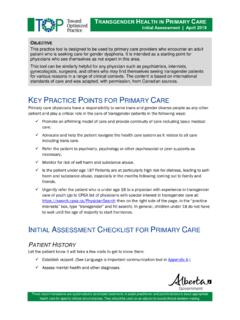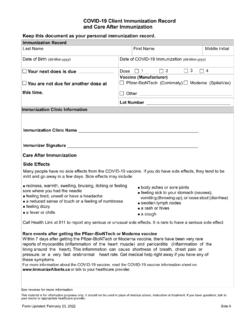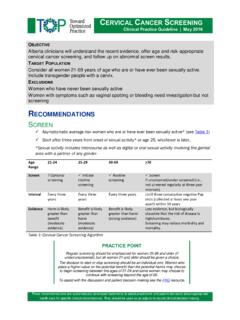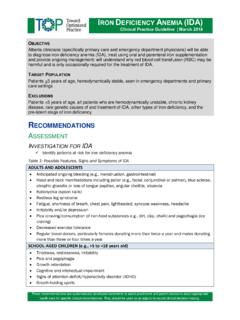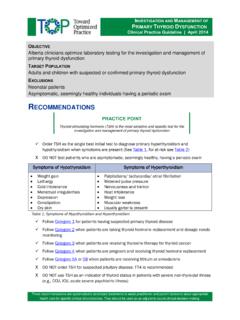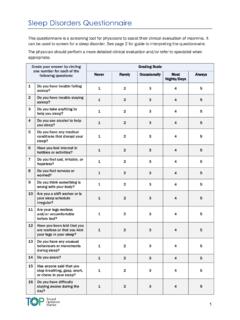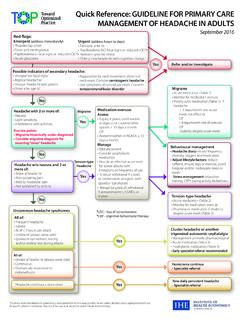Transcription of Model Care Planning Process – Overview
1 Model care Planning Process Overview November 2016 A Model comprehensive, individualized care Planning Process has been compiled from both the literature and what is known about current care Planning processes used by the care Planning initiative working group physicians and their teams. The Model care Planning Process has four main phases, summarized below. The phases can be worked through in a sequential Process to create a care plan with a patient in a single patient encounter and then managed through follow-up ( , a new care plan ). However a care plan also can be developed iteratively over a series of patient encounters, often with the contribution of multiple healthcare providers, through which more information about the patient is gathered and considered in refining the plan with the patient. Ultimately the care plan is a living document it is continually adjusted with the patient as more information becomes available, for example through patient follow-ups or assessments done by other healthcare providers.
2 Note that a complete care Planning Process also includes care plan management activities such as supporting the patient in achieving their self-management goals or coordinating care for more complex patients. care Planning The Process by which healthcare professionals and patients discuss, agree, and review an action plan to achieve the goals or behaviour change of most relevance to the patient. care plan A written document recording the outcome of the care Planning Process . Burt et al., 2014 Phase 1: Identify Comprehensive individualized care Planning with the patient is a more intensive application of the collaborative goal-setting and shared decision-making Process that characterizes patient-centred care . It is typically completed only for a subset of patients within a physician s practice who require extra time and effort to assist them in managing their chronic health conditions.
3 It is usually done to improve patient self-management, to improve communication and coordination between multiple healthcare providers, or both. The identify phase includes the following activities: Define the target patients on whom care Planning efforts will be focused. o Clarify the overall goals for care Planning : improved coordination of care , improved patient self-management or both o Determine the group of patients you will focus your care Planning efforts on and specify the criteria you will use to identify them. Be as specific as possible, especially if an EMR query will be used to identify patients. o Periodically review the outcomes of the care Planning program to determine if the criteria for identifying patients need to be adjusted. Select and prioritize patients Each practice will develop their own processes to select patients for care Planning . Most practices described using a combination of proactive and opportunistic methods.
4 O Proactive , EMR query followed by review of the results to identify those who will be contacted to arrange a care Planning appointment. o Opportunistic A patient who is a good candidate is identified during an office visit and care Planning is recommended. The patient is either referred to another healthcare provider to start care Planning at that visit or a separate appointment for care Planning is recommended to the patient. Arrange a care Planning appointment care Planning takes time and usually a separate visit is scheduled for care Planning . o Teams mentioned that they have more success getting patients to come in for a care Planning appointment if the physician has already discussed the value of care Planning with the patient. Phase 2: Prepare When care Planning is done at a separate appointment, there is time to gather all the information that will be useful during the care Planning encounter with the patient.
5 Preparation is often done by a team member to optimize the time the physician spends with the patient. When preparation is possible, it can include the following activities: Update the EMR patient record, if necessary, using Netcare or other resources For example, medication and non-medication treatments, lab tests or other diagnostics, consult reports from specialists or other healthcare providers. Prepare a patient profile for use during the care Planning encounter o Many teams use a patient profile within the EMR that compiles the most essential information about the patient into a format that is readily consulted during the care Planning encounter. Form an initial medical care plan using clinical decision support tools as needed ( , in the EMR or from other sources such as clinical practice guidelines or clinical pathways outside of the EMR). This may include specifying targets for the conditions of interest, recommended screening, recommended treatments, recommended monitoring, and recommended referrals to other team members or a specialist.
6 If appropriate, ask the patient to prepare for the care Planning session o For example, patients could be asked to complete a questionnaire or other self-assessment tool(s) that they bring to the appointment. Phase 3: plan (with the patient) The actual care Planning encounter with the patient is described by most teams as an organic or fluid Process that isn t always sequential. Some activities may not be needed for example, gathering or confirming patient information if this was done prior to the encounter, or additional assessments. However some activities that are the essence of a collaborative Process should always be included: developing shared understanding, setting goals collaboratively, developing an action plan for the patient and healthcare team collaboratively, and confirming shared understanding. Creating a new care plan for a patient will be different than updating a care plan that has already been developed.
7 Typical activities that occur during a care Planning encounter with the patient include: Gather (new care plan ) or confirm patient information What is gathered or confirmed may be determined by what is going to be included in the final care plan document. Confirming patient information is sometimes done by an office staff person before the care Planning encounter. o Examples: height, weight, allergies, personal contact information and contact preferences including preferred name, contact information for supporters or carers ( , family member or other significant supporter), contact information for other healthcare providers ( , specialist physician, community pharmacist, home care nurse, physiotherapist, social worker, psychologist) Additional assessments as needed - Brief assessments are often done informally during a care Planning encounter. More in-depth assessments using standardized tools can be done during the encounter if needed or the patient can be referred to another healthcare provider for assessment as part of the care plan , social worker, home care nurse, etc.
8 O Advance care Planning and goals of care (if not in place) o Psychological status , mood, cognition, stress o Frailty o Social and support systems home, work, financial considerations o Activities of daily living o Self-management status, self-management capability and self-efficacy, autonomy o Medication management o Prospective risk assessment Develop shared understanding The following factors will influence the care plan and should be explored with the patient prior to creating an action plan : o Patient s understanding of their condition and its treatment o Patient experience with the healthcare system o Patient values, beliefs and outcome preferences Set goals collaboratively Building on what is learned in discussion with the patient, together decide on: o Medical goals and targets Discuss priorities in the initial medical care plan and adjust as necessary in light of what is learned about the patient.
9 O Patient priority issues and goals for self-management. Goals should be documented in a SMART format if possible. (specific, measurable, achievable, relevant, time bound) Create an action plan collaboratively An action plan is typically composed of small, short-term achievable goals that enable the patient to reach longer term goals over time. It will usually include actions for the healthcare team to take and actions for the patient to take. o Medical action plan what the healthcare team will do ( , referrals, care coordination, follow-up, etc) o Patient action plan what the patient will do. This is essential if improved patient self-management is one of the purposes for undertaking care Planning . The patient should help identify strategies, activities and workable solutions that they can commit to in order to work towards their goals. Assess patient confidence in following through with their plan .
10 O Coping plan Part of the patient action plan is a coping plan that identifies potential barriers to success and what can be done if these are encountered. o Follow-up plan Who will follow-up with whom, when, how and about what. Consider telephone follow-ups to support patient in their self-management activities. Determine when the patient should return to the physician s office. Confirm shared understanding o If the care plan has been developed between the patient and another healthcare provider, the physician may wish to verify the plan with the patient. o Provide the patient with a patient-specific version of the care plan that contains the information the patient needs. Phase 4: Manage Closing the loop on care Planning with follow-up activities is strongly recommended. Activities in the care plan management phase depend on what was included in the medical action plan and follow-up plan .
